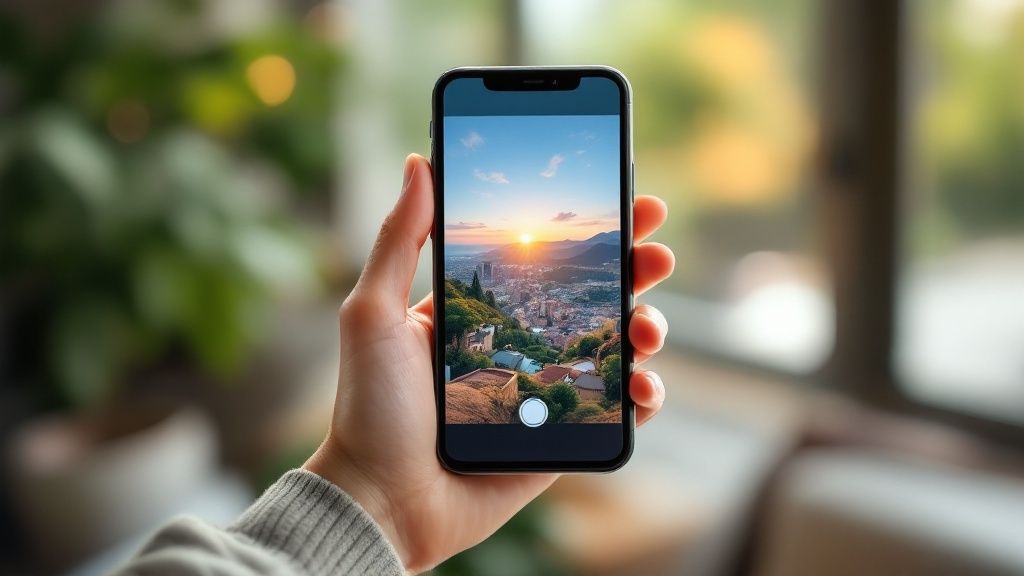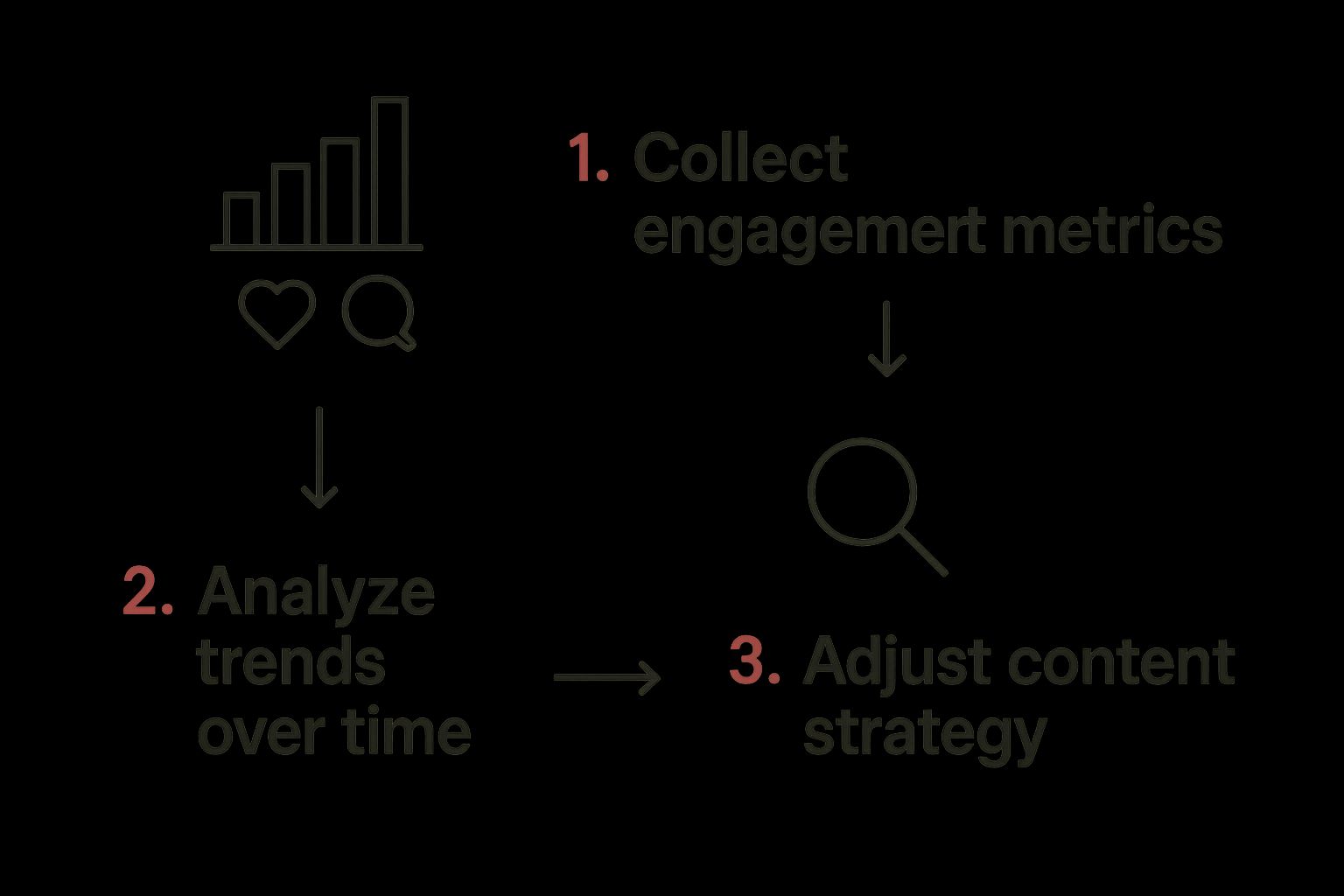Great social media isn't about shouting your message into the void; it's about building real connections. You have to understand what your audience genuinely cares about, tell stories that resonate, and start actual conversations. In today's world, success is all about authentic interaction, not just chasing vanity metrics like follower counts.
Why Most Social Media Content Fails To Engage

Let's be real for a second: the old social media playbook is collecting dust. Just posting to "stay active" only adds to the digital noise, and people have gotten incredibly good at scrolling right past generic, self-serving content. Many brands stumble because they treat their social channels like a one-way billboard instead of a community gathering spot.
At its core, the problem is a fundamental disconnect. Businesses get caught up in what they want to say, completely forgetting to ask what their audience actually wants to hear, see, or feel. The result? A feed clogged with bland promotions and corporate-speak that’s completely devoid of a human touch.
The Shift From Reach To Relationships
The game has changed because the algorithms have changed. They no longer reward you for just having a massive follower count or posting ten times a day. Instead, they’re designed to push content that sparks genuine conversation and meaningful interaction. This is a huge shift that trips up a lot of businesses still clinging to outdated metrics.
As more AI-generated content floods our feeds, platforms are doubling down on what makes them "social." They're prioritizing real human-to-human interaction, which means brands have to get serious about authenticity to see any real growth. If you want to dig into the numbers behind these trends, this report from Sprout Social is a great resource.
The goal isn't just to be seen; it's to be felt, remembered, and shared. If your content doesn't make someone stop scrolling and feel something—whether it's amusement, curiosity, or validation—it has failed.
This requires a totally new way of thinking. You have to stop acting like a publisher pushing out press releases and start behaving like a community builder who is there to connect people.
Common Pitfalls To Avoid
So, where do so many brands go wrong? The mistakes are usually pretty simple, but they have a massive impact on engagement. Spotting them in your own strategy is the first step to creating content that people actually want to see.
- Broadcasting, Not Interacting: This is the classic "post and ghost." Too many accounts just drop their content and run, never replying to comments, engaging with their followers' posts, or joining relevant conversations.
- Lacking a Clear Voice: When your content sounds like it was written by a corporate committee, it has zero personality. A consistent, authentic brand voice is what builds that feeling of familiarity and trust.
- Forgetting the "Social" Part: It's right there in the name! Content that doesn't invite a response, by asking a question, running a poll, or starting a debate, is missing the entire point of being on the platform.
Core Pillars of Modern Social Media Engagement
To truly succeed, you need to build your strategy on a few key principles. These pillars are the foundation for creating content that doesn't just get seen but gets people talking.
| Pillar | Focus Area | Why It Matters |
|---|---|---|
| Authenticity | Genuine Voice & Values | People connect with real personalities, not faceless corporations. Being transparent and true to your brand builds lasting trust. |
| Value | Education & Entertainment | Your content must solve a problem, answer a question, or provide a moment of joy. It needs to give more than it asks for. |
| Community | Two-Way Conversation | Engagement is a dialogue. Actively listen to your audience, respond to them, and create a space where they feel heard. |
| Consistency | Reliable Presence & Tone | Showing up regularly with a consistent voice and message makes your brand feel familiar and dependable, keeping you top-of-mind. |
Ultimately, creating engaging social media content isn't about having the biggest marketing budget or the most polished graphics. It’s about empathy, authenticity, and a real commitment to bringing value to your audience, one post at a time.
Know Your Audience (Really Know Them)

If your content is falling flat, it's probably not because your product is wrong. It's because you're talking to a ghost. The absolute cornerstone of engaging social media is knowing your audience, but too many brands stop at surface-level data like age, gender, and location. Those are just facts; they don't tell you a thing about what makes someone stop their scroll.
To create content that genuinely connects, you have to dig much deeper. You need to get a feel for their hopes, their biggest frustrations, and what they’re actually looking for when they open an app. This means shifting your entire focus from who they are to why they do what they do.
Go Beyond Demographics to Psychographics
Demographics will tell you that your customer is a 35-year-old woman living in the suburbs. That's a start. But psychographics tell you she's a busy working mom who feels completely overwhelmed by meal planning, values anything that saves her time, and secretly dreams of having a moment to herself. Now which one of those gives you better content ideas?
This deeper understanding comes from exploring psychographics, the attitudes, values, and interests that actually drive behavior. It’s the difference between shouting into a faceless crowd and having a real conversation.
Think about things like:
- Values & Beliefs: What really matters to them? Are they driven by sustainability, family life, or personal growth?
- Interests & Hobbies: What do they do when they’re not working? Are they into fitness, DIY projects, or binge-watching the latest Netflix series?
- Lifestyle & Aspirations: What does a typical day look like for them, and what are the big goals they're working toward?
When you build this complete picture, you can create content that speaks directly to their inner world. It makes them feel like you get them.
You aren't just selling a product; you're solving a human problem. Your content has to show you understand that problem from their perspective, not just from your company's marketing brief.
This is where the magic really happens. A post that says, "We see you, stressed-out parent trying to figure out dinner," will always outperform one that just lists the features of a new kitchen gadget. Always.
Use Social Listening to Uncover Hidden Needs
So, where do you find all this juicy information? Simple. You listen.
Social listening is essentially being a fly on the wall in your audience's digital hangouts. It’s about monitoring conversations happening around your industry, your brand, and even your competitors to pull out real, actionable insights.
You don't need expensive tools to get started, either. Just hop on X or Instagram and search for relevant keywords and hashtags. Dive into the Facebook Groups or Reddit communities where your ideal customers are already talking.
Pay close attention to the language they use. What questions pop up over and over again? What are their biggest complaints? These conversations are a goldmine of content ideas practically guaranteed to resonate because they come straight from the source. This is how you start creating engaging social media content that feels less like an ad and more like a helpful tip from a friend.
Choose Platforms Based on Mindset, Not Just Size
Finally, a deep understanding of your audience helps you show up in the right places. And I don't mean just picking the platform with the most users. It’s about understanding the mindset people are in when they use each platform. User intent is everything. The same person acts completely differently on LinkedIn than they do on TikTok.
Let's break it down:
| Platform | User Mindset & Intent | Content That Clicks |
|---|---|---|
| Professional growth, networking, industry news. People are in a "career" frame of mind, looking for valuable insights. | Thought leadership, deep-dive articles, case studies, and company news. The tone is educational and buttoned-up. | |
| TikTok | Entertainment, discovery, and a quick escape. Users want to be amused or learn something fast in a fun, low-effort way. | Short-form videos, trending challenges, behind-the-scenes glimpses, and quick, entertaining tutorials. The tone is casual and creative. |
| Visual inspiration and social connection. People are looking for beautiful images, relatable stories, and what's new or popular. | High-quality photos, Reels, story-driven carousels, and user-generated content. The vibe is aspirational but authentic. |
Don't just chase the biggest numbers. Be where your audience is most receptive to your message. A financial advisor explaining retirement planning will find a much more engaged crowd on LinkedIn than on TikTok. On the flip side, a brand selling quirky phone cases belongs on TikTok. Matching your content to the platform's native culture is non-negotiable if you want to see real engagement.
Choosing Content Formats That Drive Interaction

Alright, so you know who you’re talking to. The next piece of the puzzle is figuring out how to talk to them. The format you pick is just as critical as the message itself. A brilliant idea in the wrong package will get scrolled past without a second thought.
Not all content types are created equal. Each has its own superpower, and the real secret to creating engaging social media content is matching the right format to your goal and what people expect to see on that platform. It’s less about chasing every shiny new trend and more about strategically picking the best tool for the job.
Think about it: a quick, exciting announcement is perfect for an Instagram Story. But a deeper, more emotional brand story? That’ll land much better as a multi-slide carousel post. Getting this right is what separates the posts that get ignored from the ones that get shared, saved, and talked about.
The Undeniable Power of Visuals
Let's start with a non-negotiable: your content has to be visual. We’re wired to process images faster than text, which makes a strong visual the ultimate scroll-stopper. Whether it's a photo, a custom graphic, or a video, it has to be visually appealing to earn even a moment of someone's attention.
This doesn't mean you need a Hollywood-level production budget. I've seen clean, well-lit photos taken on a smartphone outperform glossy studio shots because they feel more authentic and relatable. The goal is to create something that looks intentional and fits your brand's personality.
Interestingly, despite the massive push for video, static images still pack a punch. According to some reports, single photo posts on Instagram often see very high engagement rates, sometimes beating both carousels and videos. You can dig into more social media statistics to see how different content types perform.
Mastering Short-Form Video
Right now, short-form video, like Instagram Reels and TikToks, is an absolute engagement machine. These quick, dynamic videos are designed to be "sticky." They grab your attention in the first three seconds and hold it with fast-paced editing, trending audio, and relatable scenarios.
Their magic comes from their ability to entertain and educate in a super condensed, easy-to-digest way. They feel less like an ad and more like something you'd see from a friend, which is why people are so receptive to them.
Here are a few ways brands use short-form video effectively:
- Quick "How-To" Demos: Show a simple process, like how to use your product or a quick industry tip.
- Behind-the-Scenes Peeks: Introduce your team or reveal how something is made. It really helps humanize your brand.
- Before-and-After Transformations: This format is incredibly satisfying and works for almost any industry, from home organizing to fitness coaching.
- Hopping on Relevant Trends: Use trending audio or video formats to connect your brand to a larger cultural conversation.
The key to great short-form video isn't perfection; it's personality. Authenticity and relatability will always outperform slick production that feels cold and corporate.
The Storytelling Strength of Carousels
While video is fantastic for quick hits of entertainment, carousel posts are your go-to for telling a deeper story or breaking down a complex topic. These multi-slide posts literally invite people to slow down and swipe, giving you more time to build a narrative and deliver real value.
I like to think of a carousel as a mini-presentation. Your first slide needs a strong hook to grab attention. Then, each slide should build on the last, leading to a satisfying conclusion or a clear call to action on the final slide.
This format is perfect for:
- Educational Content: Break down a big idea into simple, bite-sized steps.
- Photo Dumps: Share a collection of behind-the-scenes images from an event or project.
- Telling a Story: Walk your audience through a customer success story or your brand's origin.
- Showcasing a Product: Use each slide to highlight a different feature or benefit.
Ultimately, the best approach is a mixed one. By varying your content formats, you keep your feed feeling fresh and appeal to different segments of your audience. That way, there's always something compelling for everyone to sink their teeth into.
Building a Community, Not Just a Following
https://www.youtube.com/embed/jIH56PHcdv4
It’s easy to get caught up in follower counts. But a huge number on your profile means nothing if the audience is silent. The real goal isn't just to broadcast your message; it's to build a genuine community where people actually want to participate. This is how you transform passive scrollers into loyal brand advocates.
Think of it this way: you're not talking to a faceless mob. You're connecting with individuals. When you move past simply replying to comments and start creating experiences people want to be a part of, that's when the magic happens. It’s all about making your followers feel seen, heard, and genuinely valued.
From Follower Data to Personal Connection
The audience data you collect is a goldmine for building these relationships. Instead of just using it to target ads, dig into it to understand what different segments of your audience truly care about. This insight allows you to create more personalized, shareable content that speaks directly to them.
Personalization is a core expectation. In fact, getting this right on social media could generate significant value, and a staggering 71% of consumers now anticipate tailored interactions from brands. The proof is in the numbers. Companies that get this right have seen notable improvements in conversions. You can discover more insights about social media personalization and see just how powerful it can be.
Your job isn't just to manage a social media account; it's to host a conversation. The best brands create a space where their audience feels comfortable sharing their own thoughts and experiences.
This requires a community management plan that's more than just putting out fires. It’s about proactively cultivating a positive, interactive space where people actually want to spend their time. A huge piece of this is handling all feedback, the good and the bad, with grace. Remember, your public responses are a direct reflection of your brand's values. For a deeper dive, check out our guide on the best practices for online reputation management.
Turn Your Audience into Your Best Content Creators
One of the most authentic and powerful tools you have is user-generated content (UGC). When a customer posts a photo with your product or shares a great experience, that’s the most genuine endorsement you can get. Featuring their content is a win-win.
- It provides powerful social proof: It shows potential customers that real people love what you do.
- It makes your audience feel valued: Getting a shout-out from a brand is a huge thrill and encourages others to share, too.
- It helps fill your content calendar: UGC gives you a stream of authentic material without you having to create it all from scratch.
A simple way to get the ball rolling is to run a photo contest or create a unique branded hashtag. This makes it incredibly easy to find, share, and celebrate the posts from your community.
Join Conversations Outside Your Own Feed
Building a community doesn’t stop at the borders of your own profile. You have to show up where your audience is already hanging out. This means getting out of your own notifications and joining relevant conversations happening across the platform.
Here's what that might look like in practice:
- Engaging with other brands: Drop a thoughtful comment on a post from a non-competing business in your niche.
- Participating in industry discussions: Add your two cents to conversations happening under relevant industry hashtags.
- Answering questions: Find people asking for advice in your area of expertise and offer genuine help—no strings attached.
This strategy positions your brand as a helpful, knowledgeable resource, not just another company trying to make a sale. By consistently showing up, providing real value, and celebrating your audience, you’ll be well on your way to building a thriving community that helps do the work of creating engaging social media content for you.
Your Sustainable Content Creation Workflow
Great ideas are just the beginning. Without a solid system to bring those ideas to life consistently, even the best concepts will gather digital dust. Building a sustainable workflow is the secret to creating engaging social media content without burning out. It’s all about being intentional, efficient, and strategic.
This isn’t about building some rigid, soul-crushing schedule. Think of it as a framework that frees up your creative energy by taking care of the repetitive, logistical parts of content creation. It’s the engine that turns your strategy into reality, one post at a time.

The Power of Batching Your Content
One of the single most effective ways to reclaim your time and sanity is content batching. It’s a simple idea: create all your content for a set period, say, a week or two, in a single, focused session. Instead of scrambling every single morning to figure out what to post, you dedicate a block of time to get it all done at once.
For example, you could block off Monday morning to write all of your captions for the week. Then, use the afternoon to design the graphics or edit the videos that go with them. This approach is a total game-changer because it lets you get into a creative flow state, which is way more efficient than constantly switching hats between writer, designer, and strategist.
This process is an absolute lifeline for small teams and solo entrepreneurs. For a deeper dive into making this work, our guide on social media tips for small business owners has more practical advice.
Designing a Simple Approval Process
Even if you’re a team of one, having a clear approval process helps maintain quality and consistency. If you work with others, this step is non-negotiable for avoiding confusion and sloppy, last-minute edits. The goal here is simplicity, not bureaucracy.
A straightforward approval workflow might look like this:
- Drafting: The creator puts together the post (both the copy and the visual).
- Review: A designated teammate checks it for brand voice, accuracy, and any typos.
- Final Approval: The post gets the green light and moves to the "ready to schedule" pile.
Using a shared tool, like a simple spreadsheet or a project management app like Trello or Asana, makes this whole process transparent and keeps everyone on the same page. This simple step eliminates those frantic "did you see my email?" moments and ensures every piece of content is polished before it goes live.
Creating a Content Calendar That Works
A content calendar is your roadmap. It's where you plan out what you'll post, when you'll post it, and on which platform. A good calendar gives you a bird's-eye view of your upcoming content, making sure you have a healthy mix of themes and formats.
But please, don't overcomplicate it. Your calendar should be a tool that helps, not a chore that hinders. I always recommend starting with a simple structure that outlines your daily themes or key content pillars.
To give you an idea, here’s a sample framework you can adapt to fit your brand.
Sample Weekly Content Calendar Theme
This structure provides a simple yet effective way to plan a week's worth of content, ensuring you're not just selling but are actively building a community through varied and valuable posts.
| Day of Week | Content Theme | Example Post Idea |
|---|---|---|
| Monday | Educational Tip | A carousel post breaking down a common industry myth. |
| Tuesday | Behind-the-Scenes | A quick Reel showing your team working on a new project. |
| Wednesday | Community Spotlight | Share a piece of user-generated content with a thank you. |
| Thursday | Ask the Audience | A poll in your stories asking for opinions on a new idea. |
| Friday | Celebrate a Win | A post highlighting a recent success or positive customer review. |
By sticking to a themed schedule, you take the guesswork out of daily content creation while still providing consistent value to your followers.
The best workflow is the one you can actually stick to. Start simple, find what feels sustainable for you and your team, and then refine it over time as you learn what works.
The final piece of an efficient workflow is getting smart about repurposing your top performers. When a post does exceptionally well, don’t just let it fade into the digital abyss. Turn a successful blog post into an Instagram carousel, a great video into a series of short clips for TikTok, or a compelling statistic into a sharp-looking infographic.
This approach maximizes the value of your best ideas and ensures your efforts continue to pay dividends long after the initial post. It’s the ultimate way to work smarter, not harder.
Measuring What Matters for Real Growth
It’s easy to get caught up in the thrill of watching likes and follower counts tick up. But let's be honest, those are vanity metrics. They look good on paper, but they don't tell you if your content is actually connecting with people or helping your business.
Creating great social media content is less about a single home run and more about a consistent series of base hits. To do that, you have to stop guessing and start looking at the data that reveals real connection and intent. This is how you turn your social media from a time-sink into a genuine growth engine.
KPIs That Tell the Real Story
So, what should you be tracking? Certain metrics tell a much richer story about how your audience actually feels about what you’re posting. Focusing on these Key Performance Indicators (KPIs) helps you separate what truly resonates from what’s just background noise.
Think of it this way: a "like" is a quick nod. A "save," "share," or a thoughtful "comment" is someone pulling up a chair to have a conversation.
Here are the metrics that signal you're on the right track:
- Share Rate: This is the ultimate stamp of approval. When someone shares your post, they’re essentially vouching for your content to their own friends and followers. It’s a powerful sign that what you created was so valuable, they were willing to stake their own reputation on it.
- Save Rate: On platforms like Instagram, saves are pure gold. A save means your content was so useful or inspiring that someone wants to revisit it. This is a massive win for any educational, how-to, or inspirational content you create.
- Comment Sentiment: Don't just count the comments; you have to read them. Are people asking genuine questions? Are they tagging their friends? Are they sharing their own stories? Positive, in-depth comments are a clear sign you’re building a community, not just an audience.
The most powerful data isn't just about what happened; it’s about why it happened. A sudden spike in shares on a particular post tells you that the topic, format, and tone struck a chord. That's a thread you need to pull.
Using Your Built-In Analytics to Find the Wins
You don't need to shell out for expensive tools to get started. Every major platform has its own native analytics that are packed with valuable information. It's time to get comfortable digging into your Instagram Insights, Facebook Business Suite, or TikTok Analytics.
Start by looking for your top-performing posts over the last 30 days. But don't just stop at identifying them. Analyze them. What do they have in common? Was it the format (video vs. carousel)? The topic? The tone of the caption? The time you posted? Spotting these patterns is the first real step toward creating a repeatable formula for success.
Run a Simple Monthly Content Audit
To make this a habit, block off a little time once a month for a quick content audit. This isn't some soul-crushing, day-long report. Just open a simple spreadsheet and review your performance against the KPIs you've decided to track.
Your monthly check-in should answer three straightforward questions:
- What Worked? Pinpoint your top 3-5 posts based on shares, saves, and meaningful comments. Your goal for the next month is to create more content just like this.
- What Didn't? Find the posts that completely flopped. Was there a common denominator? Don't be afraid to be ruthless and stop making content your audience is clearly ignoring.
- What Can We Test? Based on what you’ve learned, what’s one new idea you can try next month? Maybe it’s a new video style, a different type of question in your captions, or a trending audio clip.
This simple ritual keeps your strategy from getting stale. It forces you to constantly refine your approach, cut what isn't working, and double down on the content that actually builds real, measurable growth.
Got Questions? We've Got Answers.
Even the best social media plans run into real-world questions. Here are some of the most common ones that come up, along with practical answers to help you navigate them.
How Often Should I Actually Be Posting?
This is the classic question, and the honest answer is: there's no single magic number. What truly matters is consistency, not just raw frequency.
It's far better to post three amazing, high-value posts per week, every single week, than to post seven mediocre ones and then burn out. Start with a schedule you know you can stick with. Check your analytics to see when your followers are online and engaging, and let that data guide your timing.
What Are the Best Free Tools for Making My Content Look Good?
You don't need a huge budget to create professional-looking visuals. A couple of free tools can cover almost everything you need.
- For graphics:Canva is the undisputed champion here. Its free version is incredibly robust, packed with templates for just about any social media format you can think of. Adobe Express is another fantastic, user-friendly option.
- For video:CapCut has become the go-to for editing short-form videos like Reels and TikToks. It’s surprisingly powerful for a free tool and works on both mobile and desktop.
How Can I Find Trending Topics and Audio Before They're Over?
The key is to use the discovery features built right into the platforms.
On TikTok, spend time scrolling your 'For You' page and check out the official 'Creative Center' for data on what’s actually trending. For Instagram, pay attention to the Reels feed. You'll see a small upward-pointing arrow next to audio clips that are gaining momentum. Jump on those early!
Ready to stop guessing and start growing? Digital Lotus Marketing creates personalized social media strategies that build real community and drive measurable results for your business. Let us help you connect with your audience. Get your custom marketing plan today!
Article created using Outrank






